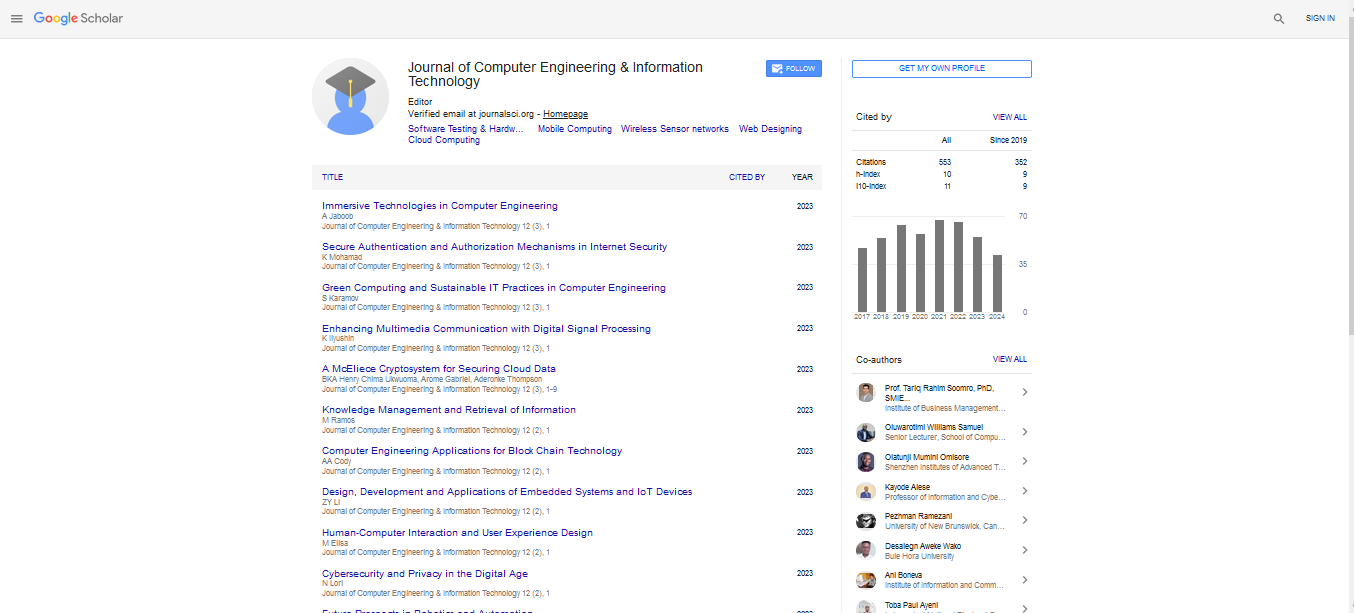Editorial, Jceit Vol: 14 Issue: 1
Kubernetes: Orchestrating the Future of Cloud-Native Infrastructure
Pravati Panday*
Department of CSE, National Institute of Technology Goa, Goa, India
- *Corresponding Author:
- Pravati Panday
Department of CSE, National Institute of Technology Goa, Goa, India
E-mail: panday_p@gmail.com
Received: 01-Jan-2025, Manuscript No. jceit-25-169314; Editor assigned: 4-Jan-2025, Pre-QC No. jceit-25-169314 (PQ); Reviewed: 20-Jan-2025, QC No jceit-25-169314; Revised: 27-Jan-2025, Manuscript No. jceit-25-169314 (R); Published: 31-Jan-2025, DOI: 10.4172/2324-9307.1000336
Citation: Pravati P (2025) Kubernetes: Orchestrating the Future of Cloud-Native Infrastructure. J Comput Eng Inf Technol 14: 336
Introduction
In the rapidly evolving world of software development and cloud computing, speed, scalability, and resilience are essential. As applications grow in complexity [1], managing them manually becomes not only inefficient but error-prone. Enter Kubernetes—an open-source container orchestration platform that has revolutionized how we deploy, scale, and manage containerized applications.
Initially developed by Google and now maintained by the Cloud Native Computing Foundation (CNCF), Kubernetes has emerged as the de facto standard for container orchestration. Its widespread adoption across industries—from startups to Fortune 500 companies—underscores its importance in modern DevOps and cloud-native ecosystems.
As organizations move toward microservices and hybrid cloud environments, Kubernetes plays a central role in enabling agility, reliability, and operational efficiency. Understanding its value and implications is key to thriving in today's digital landscape.
What Is Kubernetes and Why It Matters
Kubernetes, often abbreviated as K8s, automates the deployment, scaling, and management of containerized applications. Containers—such as those created with Docker—allow developers to package applications with all their dependencies, ensuring consistent environments across development, testing, and production [2]. However, managing thousands of containers manually is nearly impossible. That’s where Kubernetes comes in.
At its core, Kubernetes offers:
- Automatic scaling: Adds or removes containers based on load.
- Self-healing: Automatically replaces or restarts failed containers [3].
- Service discovery and load balancing: Routes traffic to the right containers.
- Rolling updates and rollbacks: Seamlessly updates applications without downtime.
These capabilities make Kubernetes a cornerstone of DevOps, continuous deployment, and cloud-native architectures.
Real-World Applications and Impact
The benefits of Kubernetes are far-reaching and visible across many sectors:
- Tech Industry: Companies like Spotify, Airbnb, and Pinterest use Kubernetes to manage microservices at scale, enabling frequent feature releases and rapid innovation [4].
- Finance: Financial institutions leverage Kubernetes for secure, scalable services like real-time fraud detection, transaction processing, and API management.
- Healthcare: Providers use Kubernetes to manage patient data systems, telemedicine platforms, and AI-driven diagnostics, ensuring uptime and reliability.
- Retail: E-commerce platforms rely on Kubernetes to handle traffic spikes during events like Black Friday or flash sales, delivering seamless user experiences.
As businesses continue to digitize, Kubernetes enables a cloud-agnostic strategy, allowing workloads to run on public, private, or hybrid cloud environments, reducing vendor lock-in and enhancing flexibility.
Challenges in Kubernetes Adoption
Despite its advantages, adopting Kubernetes is not without challenges:
- Complexity: The learning curve for Kubernetes is steep. Setting up clusters, managing configurations, and troubleshooting requires expertise.
- Security Concerns: Misconfigured permissions, insecure images, or open ports can expose vulnerabilities. Proper [5] role-based access control (RBAC) and monitoring are essential.
- Resource Management: Kubernetes offers powerful automation, but improper tuning can lead to resource overuse or underutilization.
- Operational Overhead: Managing Kubernetes at scale—especially across multiple environments—demands robust observability, CI/CD integration, and governance.
Organizations must balance the benefits of Kubernetes with thoughtful planning, skilled teams, and supporting tools to ensure success.
The Future of Kubernetes and Cloud-Native Ecosystems
Kubernetes is not just a tool—it is the foundation of the cloud-native revolution. Its ecosystem continues to grow, with tools like Helm (package management), Istio (service mesh), and Prometheus (monitoring) enhancing its capabilities.
Looking ahead, Kubernetes is expanding beyond traditional use cases:
- Edge Computing: Lightweight Kubernetes distributions like K3s are powering applications on the edge, from IoT devices to 5G infrastructure.
- AI/ML Workloads: Kubernetes is increasingly being used to orchestrate machine learning pipelines and model training jobs.
- Platform Engineering: Many organizations are building internal developer platforms (IDPs) on top of Kubernetes to streamline development workflows.
As more organizations embrace GitOps, Infrastructure as Code (IaC), and site reliability engineering (SRE) principles, Kubernetes is positioned to be the control plane that ties everything together.
Conclusion
Kubernetes has fundamentally changed how we build and operate modern software. It empowers organizations to scale quickly, maintain reliability, and accelerate innovation in an increasingly digital world. But like any powerful technology, it requires the right knowledge, planning, and ecosystem to unlock its full potential.
As we look to the future, Kubernetes is not just a trend—it is the infrastructure backbone for cloud-native computing, DevOps, and digital transformation. Those who master it will lead the way in agility, efficiency, and resilience.
References
- Gartner (2023) Magic Quadrant for Full Life Cycle API Management.
- Postman (2024) The State of API Integration 2024 Report.
- Apigee (2023) API Management Best Practices.
- MuleSoft (2023) What is API Management?
- ProgrammableWeb (2024) API Security Challenges and Trends.
Indexed at, Google Scholar, Crossref
Indexed at, Google Scholar, Crossref
Indexed at, Google Scholar, Crossref
Indexed at, Google Scholar, Crossref
 Spanish
Spanish  Chinese
Chinese  Russian
Russian  German
German  French
French  Japanese
Japanese  Portuguese
Portuguese  Hindi
Hindi 